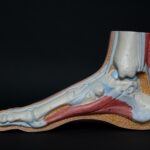Have you ever stopped to marvel at the wonders of the human body, the intricate network of tissues and organs that work harmoniously to keep us moving? Today, we venture into the captivating world of tendons, those resilient connectors that enable the fluidity of our movements. But we’re not just exploring any tendon; we’re delving into the realm of the smallest tendon, a true marvel that often goes unnoticed. Join me, a highly knowledgeable and experienced orthopedic specialist, as we unlock the secrets and gain valuable insights into the captivating world of the smallest tendon.

The Marvel of the Smallest Tendon: Insights from an Orthopedic Specialist
As an orthopedic specialist with a deep understanding of the human body, I am constantly in awe of the intricate structures that make up our musculoskeletal system. One such structure that never fails to fascinate me is the smallest tendon. Located in the inner ear, this tiny tendon attaches to the smallest muscle in the body, creating a remarkable connection that contributes to our ability to hear.
Tendons play a crucial role in our body’s movement and function. Working hand in hand with muscles, they form what is commonly known as a contractile unit. When you think about how every joint in your body moves, it’s the tendons and muscles working together that make it all happen.
While the smallest tendon in the inner ear may hold its own unique place in our body, it is important to acknowledge the largest tendon as well – the Achilles tendon. This mighty tendon connects the calf muscle to the heel bone and is responsible for our ability to walk, run, and jump. It’s incredible to think about the immense strength and resilience of tendons, especially considering the intense pressures they endure during physical activity.
However, tendons are not invincible. While they are highly resistant to tearing, they can easily be injured when strained. This is particularly true for tendons found in smaller joints of the body, such as the jaw. Everyday activities like chewing, talking, and even yawning can put strain on these tendons, making them more susceptible to injury.
To truly appreciate the marvel of the smallest tendon, it’s important to understand the structure and composition of tendons as a whole. Tendons attach muscles to bone, and the movement produced by these structures depends on the alignment of muscle fibers they are attached to. This alignment allows tendons to transmit the force generated by muscles to the bones, enabling coordinated movement.
Believe it or not, each muscle in our body has not one, but two tendons. One tendon is attached proximally, closer to the core of the body, while the other tendon is attached distally, closer to the extremities. This dual attachment ensures stability and efficiency in our movements.
Another intriguing aspect of tendons is their cellular makeup. Tendons are considered hypocellular tissues, meaning that tenoblasts and tenocytes, the cells responsible for tendon maintenance and repair, reside in less than 5% of the total volume of a tendon. This unique composition allows tendons to maintain their durability and strength while still being able to carry out their essential functions.
Deepening our understanding of tendons, we find that they have a hierarchical organization from the smallest to the largest structures within them. Collagen fibrils form collagen fibers, which in turn form primary fiber bundles. These primary fiber bundles then come together to form secondary fiber bundles, and the hierarchy continues. It’s like a network of interconnected support systems, granting tendons the ability to withstand tremendous forces.
It’s worth mentioning that tendons are primarily composed of collagen, the same protein found in ligaments, which connect bone to bone. This shared composition highlights the interconnectedness of our musculoskeletal system, with tendons and ligaments playing vital roles in our overall structure and movement.
To sum it up, the smallest tendon in the inner ear, connecting to the smallest muscle, is a testament to the incredible complexity and ingenuity of our bodies. Tendons, as a whole, are remarkable structures that allow us to carry out a wide range of physical activities with ease. Their ability to withstand immense forces and transmit the power of our muscles to our bones is truly astonishing.
So, the next time you marvel at your body’s ability to move, remember the unsung heroes – the tendons. They may be small in size, but their impact is monumental.
The human body is an intricate web of fascinating structures, each playing a vital role in our overall well-being. From the towering frame of our skeleton to the tiniest tendons that keep us agile, every part deserves our attention. Speaking of tendons, did you know that the smallest tendon in the human body holds a remarkable secret? Click here to uncover the wonders of the smallest tendon in the human body: Smallest Tendon In Human Body. It’s a fascinating journey that will leave you in awe of the intricacies of our miraculous bodies.
FAQ
Question 1
What is the smallest tendon in the body and where is it located?
Answer 1
The smallest tendon in the body is located in the inner ear, attaching to the smallest muscle in the body.
Question 2
How do tendons and muscles work together?
Answer 2
Tendons and muscles work together as a contractile unit to move your joints.
Question 3
Which tendon is the largest in the body and what does it connect?
Answer 3
The Achilles tendon is the largest tendon in the body, connecting the calf muscle to the heel bone.
Question 4
Are tendons prone to tearing or injuries?
Answer 4
Tendons are highly resistant to tearing but can be easily injured when strained.
Question 5
Where can tendons be found in the body?
Answer 5
Tendons can be found in smaller joints of the body, such as the jaw.
- Unlock Elemental 2 Secrets: Actionable Insights Now - April 2, 2025
- Lot’s Wife’s Name: Unveiling the Mystery of Sodom’s Fall - April 2, 2025
- Photocell Sensors: A Complete Guide for Selection and Implementation - April 2, 2025
















